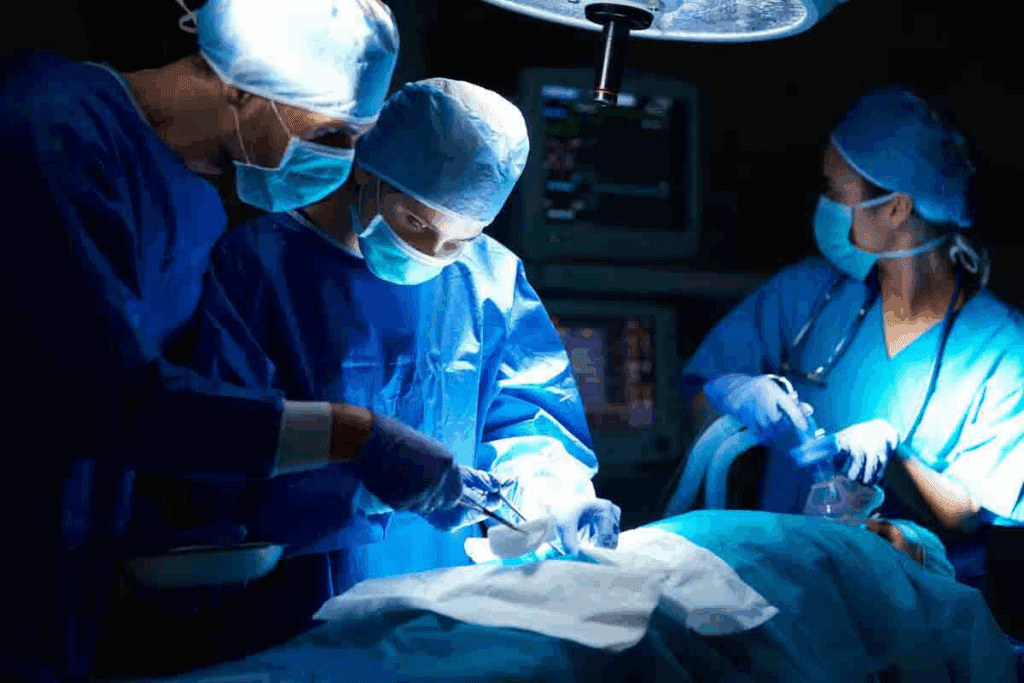Last Updated on November 17, 2025 by Ugurkan Demir

For those with life-threatening conditions, knowing about Bone Marrow Transplantation (BMT) is key. BMT, or a stem cell transplant, replaces bad bone marrow with good stem cells. This helps grow new blood cells and boosts the immune system. At LivHospital, we offer top-notch care and put patients first, giving them hope and reliable treatments. understand how bone marrow disease cure.
A bone marrow transplant can save lives for many diseases, like some cancers and blood issues. Knowing what BMT is and its benefits helps patients make better choices for their health.

Bone marrow is a spongy tissue inside some bones. It’s key to making blood cells. These cells carry oxygen, fight infections, and stop bleeding.
Bone marrow makes stem cells. These cells turn into red blood cells, white blood cells, and platelets. Red blood cells carry oxygen, white blood cells fight infections, and platelets help blood clot.
We need bone marrow to keep making these cells. Without it, our bodies can’t replace blood cells, which is vital for survival.
Blood cell production, or hematopoiesis, happens in bone marrow. Stem cells grow into different blood cells here. This process is controlled by growth factors and cytokines to keep the right balance.
Healthy bone marrow can adjust to our body’s needs. It can make more red blood cells for anemia or more white blood cells for infections.
| Type of Blood Cell | Function | Impact of Dysfunction |
| Red Blood Cells | Carry oxygen throughout the body | Anemia, fatigue |
| White Blood Cells | Fight infections and diseases | Increased susceptibility to infections |
| Platelets | Essential for blood clotting | Bleeding disorders |
When bone marrow fails, serious health problems can occur. Diseases like leukemia, lymphoma, and aplastic anemia are linked to bone marrow issues. These diseases make the bone marrow produce bad cells or not enough good cells.
Knowing how these diseases start is key to finding treatments. Bone marrow transplantation (BMT) is one treatment that tries to replace bad marrow with good.

In medical terms, BMT stands for Bone Marrow Transplant. It’s a procedure that replaces damaged or diseased bone marrow with healthy cells. This treatment is key in managing life-threatening diseases, giving hope to patients everywhere.
The BMT medical abbreviation is known in the medical field as Bone Marrow Transplantation. It involves moving stem cells into a patient’s body to replace their sick or damaged bone marrow. Knowing the BMT medical meaning is vital for both patients and healthcare workers to understand this treatment.
The history of bone marrow transplantation goes back decades, with big steps forward in recent years. It was first used for some cancers and blood disorders. Now, BMT treats a wider range of conditions. The method has changed a lot, from early attempts to today’s advanced techniques using blood and umbilical cord stem cells.
While BMT is for Bone Marrow Transplant, other terms describe similar procedures. Hematopoietic Stem Cell Transplantation (HSCT) includes bone marrow, blood, and umbilical cord stem cell transplants. It’s important to know these terms to talk clearly with healthcare providers and patients.
Exploring BMT shows its complex terminology and techniques. By grasping the BMT medical abbreviation and its meaning, patients can make better choices about their treatment.
It’s important for patients and doctors to know about the different bone marrow transplants. These procedures are designed for specific needs and conditions.
Autologous transplants use the patient’s own stem cells. They are often used for cancers like multiple myeloma or lymphoma. The bone marrow is taken out, stored, and then put back after chemotherapy.
Advantages of Autologous Transplants include less risk of graft-versus-host disease (GVHD). This is because the patient’s own cells are used, reducing immune rejection risk.
Allogeneic transplants use bone marrow or stem cells from a donor, usually a sibling or an unrelated donor. They are for patients with leukemia or other diseases affecting the bone marrow.
The success of allogeneic transplants depends on the donor and recipient’s tissue match and the recipient’s health.
Haploidentical transplants use a donor who is only a half-match to the recipient. Unrelated donor transplants use donors who are not related but have a matching tissue type.
These transplants are useful when a fully matched donor is not available. New immunosuppression and transplant techniques have improved their success.
Umbilical cord blood transplants use stem cells from the umbilical cord after birth. They are great for patients without a matched donor.
Benefits of Umbilical Cord Blood include its easy availability, lower GVHD risk, and suitability for diverse ethnic backgrounds.
BMT is a powerful treatment for many diseases, giving hope to patients everywhere. It’s a key treatment for serious diseases, making some conditions curable for the first time.
BMT is a main treatment for blood cancers like leukemias and lymphomas. Leukemia is treated by replacing bad bone marrow with healthy cells. Lymphoma can also be cured with BMT, even when other treatments fail.
“Bone marrow transplantation has changed how we treat blood cancers,” says a top hematologist. This shows how important BMT is in cancer treatment today.
Bone marrow failure syndromes, like aplastic anemia, happen when bone marrow can’t make blood cells. BMT is often the only cure, replacing bad marrow with healthy stem cells from a donor.
Some genetic and immune disorders can be treated with BMT. For example, severe combined immunodeficiency (SCID) can be cured. Other conditions like sickle cell disease and thalassemia also see improvement with BMT, giving patients a chance at a normal life.
Research is looking into new uses for BMT, like treating autoimmune diseases and some solid tumors. As technology improves, BMT’s uses will likely grow, opening up new treatment options for more conditions.
In summary, BMT is a powerful treatment that can cure many serious diseases. As research keeps advancing, we’ll see even more ways this therapy can save lives.
BMT is a powerful tool in medicine. It can cure diseases that were once thought to be untreatable. This process involves several key steps to restore health.
BMT works by replacing diseased or damaged cells with healthy stem cells. This helps the body make normal blood cells. It fixes many blood-related problems at their source.
The graft-versus-disease effect is key to BMT’s success. The new immune cells see the old diseased cells as foreign. They then attack and destroy them, helping to cure some diseases.
BMT also restores normal blood cell production. It introduces healthy stem cells into the bone marrow. This leads to the creation of healthy red and white blood cells and platelets. These are vital for the patient’s health and recovery.
Lastly, BMT rebuilds the patient’s immune system. The new stem cells create a stronger immune system. This system can better fight off infections and diseases. It improves the patient’s life and survival chances.
In summary, BMT cures disease in many ways. It replaces diseased cells, uses the graft-versus-disease effect, restores blood cell production, and rebuilds the immune system. Understanding these steps shows how important BMT is in modern medicine.
The bone marrow transplant (BMT) process is complex. It involves several key steps. We will explore the BMT process, from preparation to the transplant itself.
Before a BMT, patients get a detailed check-up. This check-up looks at their health and if they’re ready for the transplant. Pre-transplant evaluation helps find any health issues that might impact the transplant’s success.
Finding the right donor is a big part of BMT. We search for a donor whose HLA typing matches the patient’s. This matching is key to avoid graft-versus-host disease (GVHD).
Conditioning regimens get the patient ready for the transplant. They use chemotherapy and/or radiation to kill off bad cells and weaken the immune system. Conditioning regimens are made just for each patient and their specific disease.
Stem cell collection is the last step before the transplant. We can get stem cells from bone marrow, blood, or umbilical cord blood. The method used depends on the transplant type and donor. We make sure the stem cell collection is done carefully for the best transplant results.
Having a Bone Marrow Transplant (BMT) is different for everyone. Knowing what to expect can help ease worries. We focus on pain, discomfort, and recovery to help patients.
Collecting stem cells for BMT might cause some discomfort. For those using their own cells, the process is usually okay. But, some might feel mild discomfort where the cells are taken.
For those using donor cells, the donor might feel pain or discomfort. This is usually managed with medicine.
During the transplant, patients are watched closely. The stem cell infusion is not painful. But, some might feel mild reactions like flushing or coldness.
Managing pain is key in BMT care. We use medicines and other methods to reduce discomfort. Patients are watched closely, and their pain plans are adjusted as needed.
Recovery times after BMT vary. It can take weeks to months. Patients are watched for signs of new blood cell production and any problems.
Important milestones include:
Listening to patients who have had BMT offers real insights. Many say it’s tough but worth it for the benefits. One patient said, “
I was nervous about the transplant, but the care I received made all the difference. It’s been a journey, but I’m grateful for the second chance I’ve been given.
Understanding the patient experience helps us support those going through BMT. We aim to treat the medical issue and support the patient’s well-being.
Effective post-transplant care is key for BMT patients to fully recover and avoid complications. After a bone marrow transplant, the body is very vulnerable. It needs careful monitoring and management to ensure success.
Right after the transplant, patients are watched closely for signs of engraftment. This is when the new stem cells start making blood cells. They have regular blood tests to see if the donor cells are present and if blood cell counts are getting better.
Key aspects of immediate post-transplant monitoring include:
BMT patients face risks like infections, graft failure, and organ toxicity. We use prophylactic medications, close monitoring, and quick action if problems come up.
Common complications and their management strategies include:
Graft-versus-host disease (GVHD) is a big risk with allogeneic BMT. It’s when the donor’s immune cells attack the recipient’s tissues. We prevent GVHD through careful donor selection, immunosuppressive medications, and close monitoring for signs of GVHD.
Long-term follow-up is vital for BMT patients. It helps monitor for late transplant effects, manage chronic GVHD, and ensure overall health. This includes regular check-ups with the transplant team, watching for late complications, and providing support for ongoing issues.
Key aspects of long-term follow-up include:
It’s important for patients and doctors to know about BMT success rates. Bone Marrow Transplantation is a key treatment for serious diseases. Its success depends on many things.
Many things can affect how well a BMT works. The disease being treated, the patient’s health, and the donor match are key. Patient age, disease stage, and donor-recipient HLA matching are very important.
Survival rates after BMT change based on the disease. For example, some leukemia or lymphoma patients might have better survival rates than others.
| Disease | Survival Rate |
| Acute Leukemia | 40-60% |
| Lymphoma | 50-70% |
| Myeloma | 30-50% |
Quality of life after BMT is very important. The treatment can save lives but also has a big recovery time. Many patients say they get back to a normal or almost normal life after the transplant.
New advancements in BMT have made things better for patients. Better treatment plans and care have led to better survival rates and quality of life.
As we keep moving forward, research and development in BMT will likely make things even better. Understanding what affects BMT outcomes helps us support patients better during their treatment.
Bone marrow transplantation (BMT) is a complex treatment for many diseases. It has the power to save lives. The future of BMT looks bright, thanks to ongoing research and new discoveries.
Improvements in matching donors, treatment plans, and care after transplant are making BMT more successful. These changes are also lowering the risk of serious side effects. BMT is now being used to treat genetic and immune disorders, giving hope to many patients.
New technologies like stem cell therapy, gene editing, and immunotherapy will shape BMT’s future. These advancements will make BMT more effective and available to people everywhere. By keeping up with these innovations, we can provide the best care and results for patients in the future.
BMT stands for Bone Marrow Transplant. It’s a procedure that replaces damaged bone marrow with healthy stem cells. This helps the body make new blood cells and fight off infections.
Bone marrow makes blood cells like red and white blood cells, and platelets. It’s key to our immune system.
There are many types of bone marrow transplants. These include using the patient’s own stem cells (autologous) or a donor’s (allogeneic). Other types include haploidentical, unrelated donor, and umbilical cord blood transplants.
Pain from BMT varies. Some feel pain, while others don’t. There are ways to manage pain and make it more comfortable.
BMT treats many diseases. This includes blood cancers, bone marrow failure, genetic disorders, and some other conditions.
BMT involves several steps. First, the patient is evaluated and prepared. Then, a donor is selected and matched. The patient goes through conditioning and stem cell collection.
Matching donors is key in BMT. It helps avoid graft-versus-host disease (GVHD) and ensures the best outcome for the patient.
The graft-versus-disease effect is when the transplanted stem cells attack the disease. This can help get rid of cancer cells or other diseased cells.
After BMT, patients need close monitoring and care. This includes managing complications, preventing GVHD, and long-term follow-up.
BMT success rates vary. They depend on the disease, transplant type, and patient health. Survival rates and quality of life are important.
Bone marrow from a close relative is called an allogeneic transplant.
Yes, BMT can cure some diseases. This includes some blood cancers and genetic disorders.
References
Subscribe to our e-newsletter to stay informed about the latest innovations in the world of health and exclusive offers!